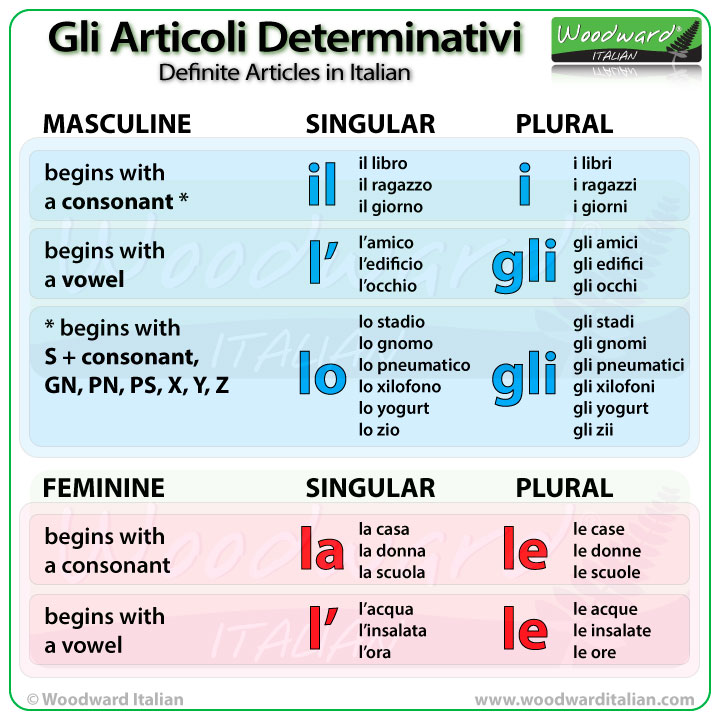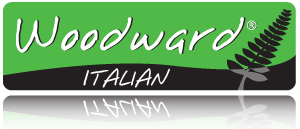Gli articoli determinativi in italiano
(Definite Articles in Italian)
In English THE is a definite article. – It refers to something specific.
- I need the book. (It is a specific book, one that we both know about)
In English, we are lucky because there is only one form of definite article…. THE
However in Italian there is more than one form of definite article. There is IL, L’, LO, LA, I, GLI, and LE.
So, what is the difference?
The article that is used in Italian depends on the noun. As we have already seen in a previous lesson, Italian nouns are either masculine or feminine. They can also come in singular or plural form.
Articles in Italian need to match:
- the gender (is the noun masculine or feminine?) and
- the number (is the noun singular or plural?)
Articles with Singular Masculine Nouns in Italian
If a singular noun is masculine then we use either IL, L’, or LO.
The most common masculine definite article (in singular form) is IL.
IL is used before a singular noun that starts with a consonant ( – see the exceptions below that use Lo)
- Il libro (= the book)
- Il telefono (= the telephone)
- Il ragazzo (= the boy)
- Il padre (= the father)
L’ is used before a singular noun that starts with a vowel (= a, e, i, o u).
- L’amico (= the friend)
- L’edificio (= the building)
- L’inverno (= the winter)
- L’occhio (= the eye)
- L’ufficio (= the office)
LO is used before a singular noun that starts with an S + consonant, as well as words that begin with GN-, PN-, PS-, X-, Y- and Z-.
- Lo stadio (= the stadium)
- Lo gnomo (= the gnome) *
- Lo pneumatico (= the tyre/tire)
- Lo psicologo (= the psychologist)
- Lo xilofono (= the xylophone)
- Lo yogurt (= the yoghurt)
- Lo zio (= the uncle)
* I’m sure you will use lo gnomo a lot on your trip to Italy 😉 …. but seriously, the GN rule exists and there are only a handful of words that begin with GN- and that was about the best word I could find. The same goes for words beginning with PS- and PN- … there aren’t many.
X and Y: One of the only words that starts with X in Italian… Lo xilofono also falls under the Lo rule as well as Lo Yogurt that starts with Y. I didn’t include them in the list of rules as it is basically only those two words that you need to remember.
Articles with Singular Feminine Nouns in Italian
If a singular noun is feminine then we use either La or L’.
LA is used before a singular noun that starts with a consonant
- La casa (= the house)
- La scuola (= the school)
- La ragazza (= the girl)
- La donna (= the woman)
L’ is used before a singular noun that starts with a vowel (= a, e, i, o u).
- L’acqua (= the water)
- L’estate (= the summer)
- L’insalata (= the salad)
- L’ora (= the hour)
- L’unghia (= the nail – fingernail or toenail)
— PLURAL ARTICLES —
Articles with Plural Masculine Nouns in Italian
If a plural noun is masculine then we use either I or GLI.
The most common masculine definite article (in plural form) is I.
I is the plural of IL.
I is used before a plural noun that starts with a consonant ( – see the exceptions below that use Gli)
- Il libro — I libri (= the books)
- Il telefono — I telefoni (= the telephones)
- Il ragazzo — I ragazzi (= the boys)
- Il padre — I padri (= the fathers)
GLI is the plural of L’ and LO.
GLI is used before a plural noun that starts with a vowel (= a, e, i, o u), with nouns that starts with an S + consonant, as well as words that begin with PS-, PN-, GN- and Z-.
- L’amico — Gli amici (= the friends)
- L’edificio — Gli edifici (= the buildings)
- L’inverno — Gli inverni (= the winters)
- L’occhio — Gli occhi (= the eyes)
- L’ufficio — Gli uffici (= the offices)
- Lo stadio — Gli stadi (= the stadiums)
- Lo gnomo — Gli gnomi (= the gnomes)
- Lo pneumatico — Gli pneumatici (= the tyres/tires)
- Lo psicologo — Gli psicologi (= the psychologists)
- Lo xilofono — Gli xilofoni (= the xylophones)
- Lo yogurt — Gli yogurt ** (= the yoghurts)
- Lo zio — Gli zii (= the uncles)
** Yogurt is the same form in singular and plural.
Articles with Plural Feminine Nouns in Italian
If a plural noun is feminine then we use the article Le.
LE is the plural of LA and L’.
LE is used before all plural feminine nouns. It doesn’t matter if it begins with a consonant or a vowel.
- La casa — Le case (= the houses)
- La scuola — Le scuole (= the schools)
- La ragazza — Le ragazze (= the girls)
- La donna — Le donne (= the women)
- L’acqua — Le acque (= the waters)
- L’estate — Le estati (= the summers)
- L’insalata — Le insalate (= the salads)
- L’ora — Le ore (= the hours)
- L’unghia — Le unghie (= the nails – fingernails or toenails)
Italian Definite Articles Summary Chart

